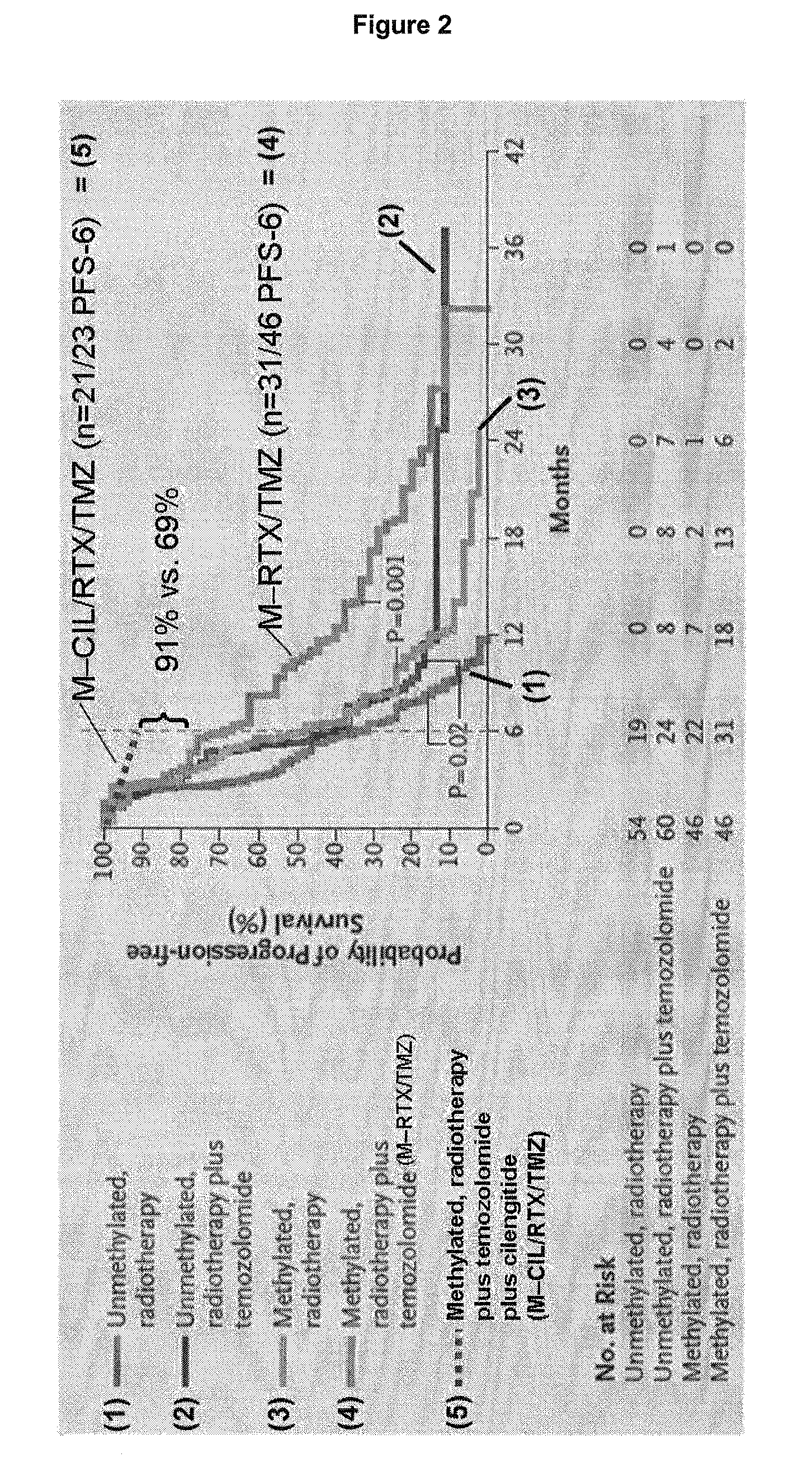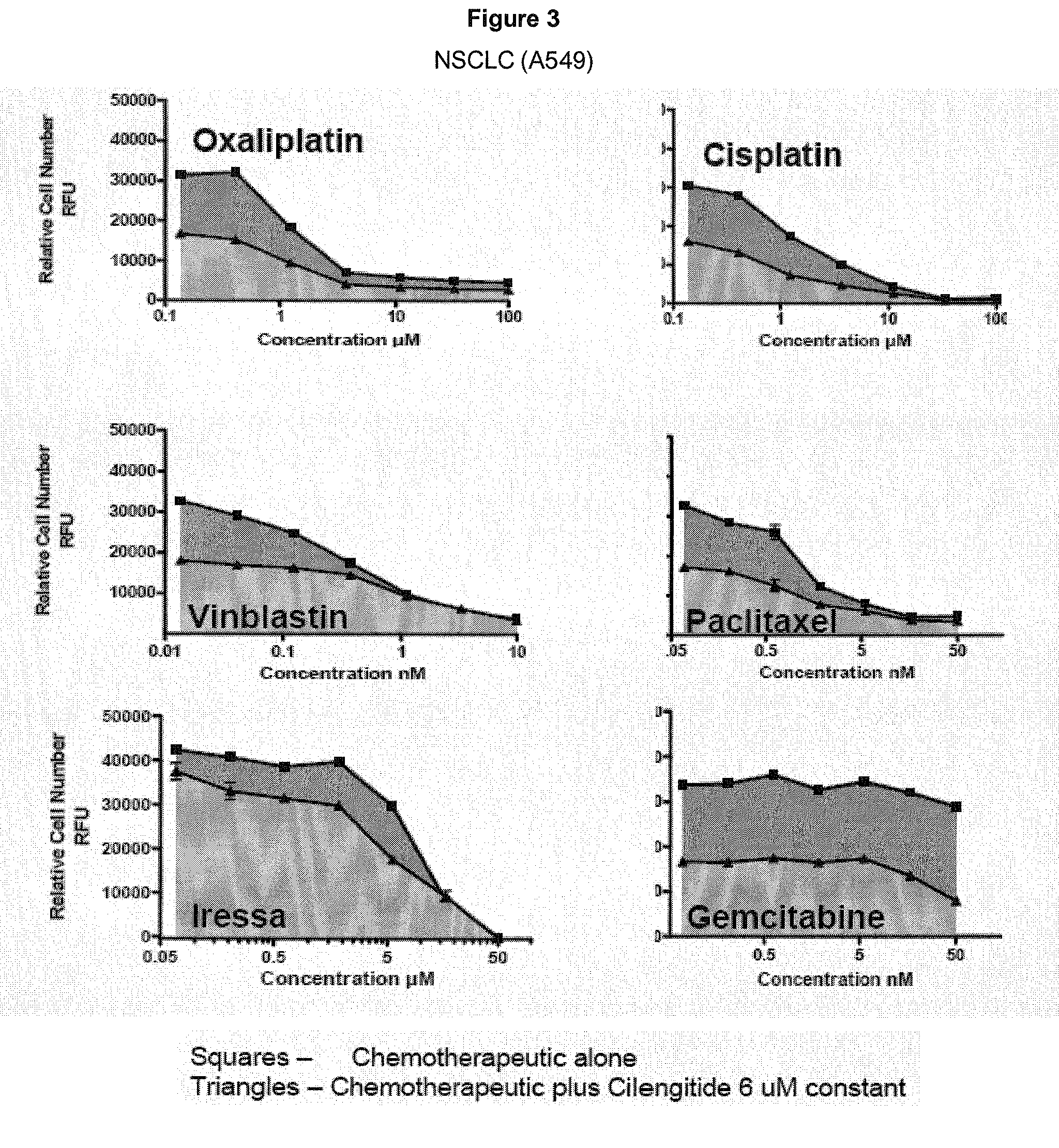Specific therapy and medicament using integrin ligands for treating cancer
a technology of integrin ligands and specific therapy, applied in the direction of peptides, drug compositions, peptides, etc., can solve the problems of systemic chemotherapy failure, decreased efficacy, and insufficient fruitful results of these therapies, and achieve enhanced progression-free survival, improved median survival, and improved tolerated
- Summary
- Abstract
- Description
- Claims
- Application Information
AI Technical Summary
Benefits of technology
Problems solved by technology
Method used
Image
Examples
example 1
Rat Orthotopic Glioblastoma Model Radiotherapy, Cilengitide (=cyclo-(Arg-Gly-Asp-DPhe-NMe-Val)) Scheduling Experiments
[1043]NIH rnu nude rats are anaesthetized, restrained, and injected intracerebrally 1 mm retro orbitally, 3mm to the right of the bregma and at a depth of 2.5 mm with 5×10E5 U251 human glioblastoma cells suspended in 10 ul of culture medium, using a #2701 Hamilton syringe fitted with a 26 gauge needle, essentially as previously described (Engebraaten et al., 1999). After 14 days, cilengitide (4 mg / kg) is given as an intraperitoneal bolus in PBS, at various time (8 h, 4 h, 2 h, 1 h) prior to a single treatment with single, collimated, dorsal-ventral beam of 6 MV x-rays, so that 95-100% of the central axis dose of 25 Gy hit the tumor volume (Kim et al., 1999). Each of the 7 subsequent days the animals also received an identical i.p. bolus of cilengitide. The animals are maintained under ad libitum food and drink until they become moribund, or are sampled for tissue ana...
example 2
Phase IIa Trial of Cilengitide ((=cyclo-(Arg-Gly-Asp-DPhe-NMe-Val))) Single Agent Therapy in Patients with Recurrent Glioblastoma
[1048]Background: The present phase IIa study was designed to evaluate the safety, toxicity, and clinical activity of the cyclic RGD pentapeptide cilengitide((=cyclo-(Arg-Gly-Asp-DPhe-NMe-Val)), an inhibitor of integrins avβ3 and avβ5, as a single agent at doses of 500 and 2000 mg in patients (pts) with recurrent glioblastoma (GBM).
[1049]Methods: In this multicenter, open-label, randomized, uncontrolled study, pts with GBM and measurable disease that had relapsed after previous therapy with temozolomide and radiotherapy were randomized to receive cilengitide at doses of either 500 mg or 2000 mg i.v., 2× / week, until progression. Histopathology diagnosis and MRI imaging were subject to independent blinded review. The primary endpoint was Progression Free Survival (PFS) at 6 months (mths). Secondary endpoints included response, survival, time to disease prog...
example 3
Phase I / IIa Trial of Cilengitide (=cyclo-(Arg-Gly-Asp-DPhe-NMe-Val)) and Temozolomide with Concomitant Radiotherapy, Followed by Temozolomide and Cilengitide Maintenance Therapy in Patients with Newly Diagnosed Glioblastoma (GBM).
[1052]Purpose: To evaluate safety, toxicity, and efficacy of the combination of the cyclic RGD pentapeptide Cilengitide (=cyclo-(Arg-Gly-Asp-DPhe-NMe-Val)), an inhibitor of integrins avβ3 and avβ5, in addition to standard temozolomide (TMZ) and radiotherapy (RT).
[1053]Patients and methods: Fifty-two pts (PS 0-1: 92%, 2: 8%; median age 57 yrs) after biopsy (n=9 / 17%) or tumor resection (n=43 / 83%) were treated with standard TMZ / RT (Stupp et al. NEJM 2005). In addition Cilengitide (500 mg i.v., 2× / week) was started one week before TMZ / RT and given throughout for the duration of chemotherapy or until progression. Primary endpoint was progression free survival rate at 6 months (target: 65%). Patients were followed with MRI every 2 months. Histopathologic diagnos...
PUM
| Property | Measurement | Unit |
|---|---|---|
| time | aaaaa | aaaaa |
| time period | aaaaa | aaaaa |
| concentration | aaaaa | aaaaa |
Abstract
Description
Claims
Application Information
 Login to View More
Login to View More - R&D
- Intellectual Property
- Life Sciences
- Materials
- Tech Scout
- Unparalleled Data Quality
- Higher Quality Content
- 60% Fewer Hallucinations
Browse by: Latest US Patents, China's latest patents, Technical Efficacy Thesaurus, Application Domain, Technology Topic, Popular Technical Reports.
© 2025 PatSnap. All rights reserved.Legal|Privacy policy|Modern Slavery Act Transparency Statement|Sitemap|About US| Contact US: help@patsnap.com



